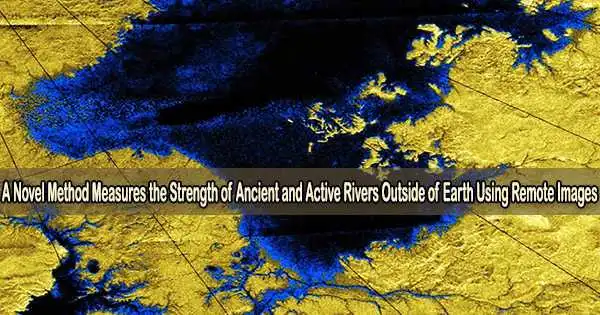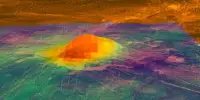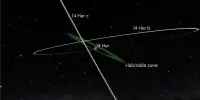In addition to Earth, rivers once ran on two other planets in the solar system: Titan, Saturn’s largest moon, where rivers of liquid methane still flow today, and Mars, where only dry trails and craters remain from ancient rivers and lakes.
Scientists may now compare the present flow of rivers on Titan to how furiously they once flowed on Mars thanks to a novel approach developed by MIT geologists. The technique estimates the speed at which rivers carry silt and liquid downstream using satellite measurements.
The MIT researchers used their novel method to determine how swift and deep the rivers were on Mars more than a billion years ago. They also provided estimations for rivers that are now flowing on Titan, despite the fact that the moon is tougher to investigate due to its thick atmosphere, distance from Earth, and lack of available photographs of its surface in comparison to Mars.
“What’s exciting about Titan is that it’s active. With this technique, we have a method to make real predictions for a place where we won’t get more data for a long time,” says Taylor Perron, the Cecil and Ida Green Professor in MIT’s Department of Earth, Atmospheric and Planetary Sciences (EAPS). “And on Mars, it gives us a time machine, to take the rivers that are dead now and get a sense of what they were like when they were actively flowing.”
Perron and his colleagues have published their results in the Proceedings of the National Academy of Sciences. Perron’s MIT co-authors are first author Samuel Birch, Paul Corlies, and Jason Soderblom, with Rose Palermo and Andrew Ashton of the Woods Hole Oceanographic Institution (WHOI), Gary Parker of the University of Illinois at Urbana-Champaign, and collaborators from the University of California at Los Angeles, Yale University, and Cornell University.
River math
The team’s study grew out of Perron and Birch’s puzzlement over Titan’s rivers. Unlike many rivers on Earth, most of the moon’s rivers do not have fan-shaped deltas at their mouths, according to photographs collected by NASA’s Cassini probe. Could it be that Titan’s rivers don’t carry enough flow or sediment to build deltas?
Titan is the most Earth-like place. We’ve only gotten a glimpse of it. There’s so much more that we know is down there, and this remote technique is pushing us a little closer.
Samuel Birch
The team expanded on the research of co-author Gary Parker, who created a set of mathematical equations to characterize river movement on Earth in the 2000s. Parker had examined measurements made of rivers by various people in the actual field.
He discovered from these statistics that there were some commonalities in the correlations between a river’s breadth, depth, slope, and flow rate. He created mathematical equations that accounted for additional factors including the gravitational field acting on the river and the size and density of the silt being carried down the river’s bed in order to mathematically characterize these interactions.
“This means that rivers with different gravity and materials should follow similar relationships,” Perron says. “That opened up a possibility to apply this to other planets too.”
Getting a glimpse
Parker’s equations can be used to precisely predict a river’s flow rate, or how much water and sediment it can carry downstream, using field measurements of a river’s width, slope, and average sediment size taken on Earth. Measurements, however, are more constrained and mostly based on photos and elevation data gathered by distant satellites for rivers on other worlds.
For Mars, multiple orbiters have taken high-resolution images of the planet. For Titan, views are few and far between.
Birch noted that any estimation of a river’s width and slope on Mars or Titan would have to be based on the limited topographic features and attributes that can be determined from remote photographs. He modified Parker’s equations using algebra to limit the inputs to width and slope only.
The forecasts based merely on each river’s breadth and slope were proved to be correct after he collected data from 491 rivers on Earth and tested the modified equations on them.
Then, he applied the equations to Mars, and specifically, to the ancient rivers leading into Gale and Jezero Craters, both of which are thought to have been water-filled lakes billions of years ago. He entered Mars’ gravity into the equations, together with estimations of each river’s breadth and slope derived from photos and elevation measurements acquired by orbiting satellites, to determine the flow rate of each river.
From their predictions of flow rate, the team found that rivers likely flowed for at least 100,000 years at Gale Crater and at least 1 million years at Jezero Crater long enough to have possibly supported life.
Additionally, they were able to contrast their estimates of the typical size of sediment on the banks of each river with real measurements of Martian grains made nearby by NASA’s Curiosity and Perseverance rovers.
These few field measurements allowed the team to check that their equations, applied on Mars, were accurate.
The team then took their approach to Titan. They focused on two places, one of which is a river that empties into a lake the size of Lake Ontario, where river slopes may be recorded. As it flows into the lake, this river seems to create a delta.
The delta, however, is one of very few things that are thought to exist on the moon; almost every river that can be seen flowing into a lake curiously lacks a delta. The team also applied their method to one of these other delta-less rivers.
With deltas believed to have a flow rate as enormous as the Mississippi, they computed the flow of both rivers and discovered that they may be similar to some of the largest rivers on Earth. Both rivers should move enough sediment to build up deltas. Yet, most rivers on Titan lack the fan-shaped deposits. Something else must be at work to explain this lack of river deposits.
In another finding, the team calculated that rivers on Titan should be wider and have a gentler slope than rivers carrying the same flow on Earth or Mars.
“Titan is the most Earth-like place,” Birch says. “We’ve only gotten a glimpse of it. There’s so much more that we know is down there, and this remote technique is pushing us a little closer.”
















